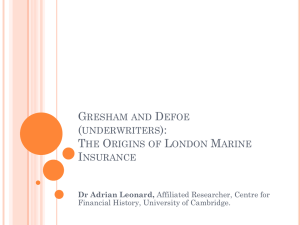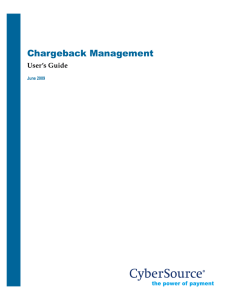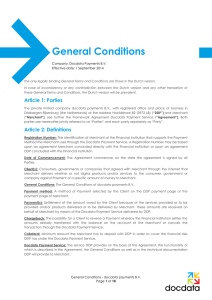Mark MacCarthy - Pace Law School
advertisement
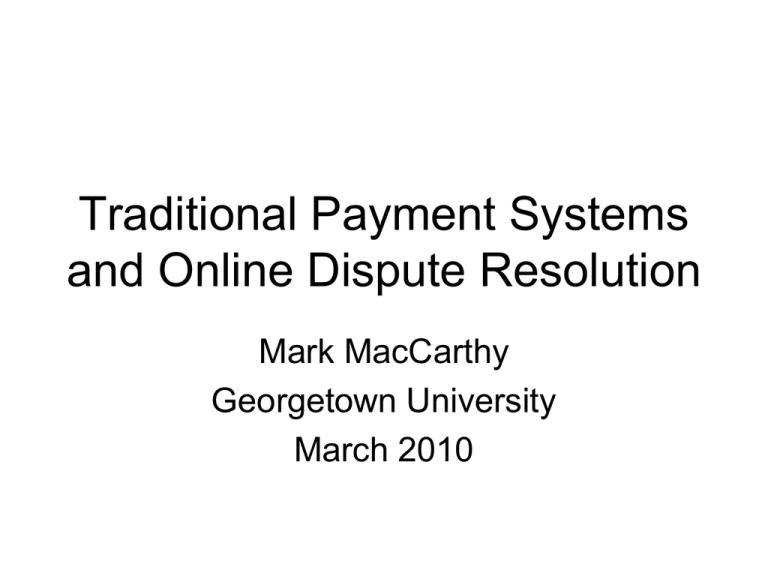
Traditional Payment Systems and Online Dispute Resolution Mark MacCarthy Georgetown University March 2010 The Puzzle • Why has cross border electronic commerce stalled? • Merchants don’t want to ship across borders • Consumers don’t want to shop across borders 2 The Facts • EU – Percentage of people engaging in electronic commerce increased from 27 to 33 – But percentage of people buying goods cross border is stagnant at 6-7% – Percentage of merchants selling across borders decreased from 29 to 21 • Only 4% of Visa US electronic transactions are cross border 3 Regulatory Problems • Merchants fear becoming subject to consumer protection laws in consumer’s home country • Consumers don’t know what to do if something goes wrong with a cross border transaction 4 A Way Forward • Payment card dispute resolution systems can – Provide consumers with confidence to shop across borders – Not subject merchants to varying consumer protection regimes • Need legislation in some countries to enable this • US OAS proposal 5 Payment System ADR • Payment networks use a form of ADR as a means of handling disputes • Chargeback mechanism resolves transaction disputes involving their payment cards – Even if the merchant and the consumer are geographically dispersed. • Practical and effective consumer protections for international electronic commerce transactions. 6 Payment System ADRs for US Cardholders Are Comprehensive • • • • Domestic International Online Offline 7 Unitary Systems • American Express, Discover • 3-Parties – Cardholder – Merchant – American Express – acts as an agent for both cardholder and merchant 8 Transaction Flow in a Closed System 1. Shop Merchant Cardholder 2. Authorization 4. Bill/Pay 3. Settlement American Express Discover 9 Distributed Systems • 4-parties plus Visa or MasterCard – Card holder – Merchant – Cardholder’s bank – Merchant’s bank – Network operator 10 Transaction Flow in an Open System 1. Shop Merchant 3 Cardholder Visa MasterCard 2 Merchant’s Bank 2 3 2 3 2. Authorization 3. Settlement 4. Bill/Pay Cardholder’s Bank 11 Chargebacks • The return of a transaction from the consumer card issuer to the merchant's financial institution • Many reasons for chargebacks • The merchant’s bank can dispute the chargeback on behalf of its merchant using the representment process • Ultimately, card networks resolve disputes that are not settled directly between the issuer and merchant bank. 12 Chargeback & Representment Shop Dispute Merchant 3 Visa MasterCard 2 Merchant’s Bank Cardholder 2 3 Dispute 2 3 2. Chargeback 3. Representment 3 Cardholder’s Bank 13 Visa Chargeback Codes • CODE • • • • • • • • • • 30 41 53 62 70 71 72 73 75 81 CHARGEBACK REASON Services Not Provided or Merchandise Not Received Cancelled Recurring Transaction Not as Described or Defective Merchandise Counterfeit Transaction Account Number on Exception File Declined Authorization No Authorization Obtained Expired Card Cardholder Does Not Recognize Transaction Fraudulent Transaction 14 MC Chargeback Codes • 4837 • 4840 • 4853 • 4854 • • • • 4855 4857 4859 4860 No Cardholder Authorization Fraudulent Processing of Transaction Cardholder Disputes– Merchandise/Services Defective/Not as Described Cardholder Disputes–Not Elsewhere Classified (U.S. Region Only) Non receipt of Merchandise Card Activated Telephone Transaction Services Not Rendered Credit Not Processed 15 Relevant Chargeback Reasons • Not received • Defective • Not as described 16 Targeted to Perceived Problems • According to the European Consumer Network (2005) – The most common complaint (46%) related to problems with delivery – non delivery, partial delivery, late delivery. – The second largest area (25%) related to defects with the goods or that they were not what was expected when first ordered. 17 Overall Merchant Responsibility • Try to resolve the dispute directly with the customer • Keep accurate records of all attempts to satisfy the customer’s dispute including names, dates, and times. 18 Cardholder Responsibility • Customer must make a valid attempt directly with the merchant to resolve the dispute BEFORE processing the chargeback. 19 Non-Receipt of Goods or Services • If customers do not receive their merchandise or services, they may pursue a “Non-Receipt of Merchandise/Services” Chargeback. 20 Merchant Responsibilities • Goods or services that were not immediately delivered at the point-of-sale must be delivered BEFORE charging the Customer’s Credit Card. • Once merchandise has been shipped or services have been rendered, merchant must obtain signed proof of delivery of goods or services. 21 Defective or Not As Described • If customers feel that service or merchandise was received in an unsatisfactory condition (Defective) or if they feel the service or merchandise they received was not what they expected (Not As Described), they can initiate a chargeback. 22 Merchant Responsibilities • Keep a detailed invoice detailing exactly what merchandise was to be received or what service was to be rendered. • Include dates, times, locations, item colors, sizes, etc • For internet merchants, the merchandise and final prices should match the description provided on the website. 23 Merchant Responsibilities • Make sure all delivered items are packed properly • Make sure that the goods are suitable for the purpose for which they were sold. • It is the merchant’s responsibility to ensure that merchandise is delivered to the proper address and in perfect condition. 24 Restrictions on Merchant Contracts • Merchant’s Return/Refund policy cannot be enforced instead of the chargeback process • An invoice or contract signed by the cardholder waiving their right to process a chargeback against the transaction is not permitted and cannot be used to reverse a chargeback. 25 Basis for Chargebacks • Chargebacks are contractual rights and obligations between the financial institutions in payment networks • They give no direct rights to consumers • Their exercise is optional for issuers. 26 US Chargeback Protections • US chargebacks track US consumer protection laws • Protect US cardholders wherever they shop – Domestic – International – Online – Offline 27 Truth in Lending Act • The Truth in Lending Act passed by Congress in 1968. • Major amendments made by the Fair Credit Billing Act of 1974 • The implementation through Federal Reserve Board's Regulation Z • Provides protection against unauthorized use • Requires creditors to promptly correct billing errors • Entitles consumers to maintain against issuer the same claims that they might assert against a merchant in connection with the purchase of defective or otherwise unsatisfactory goods and services. 28 Electronic Funds Transfer Act • EFTA passed by Congress in 1978. • Implemented through Federal Reserve Board’s Regulation E • Provides protections against unauthorized use and billing errors • Does not provide redress to a consumer who has purchased allegedly defective goods or services using a debit card. 29 Debit Cards in US • For debit and prepaid cards in US, card networks provide issuing banks with the same chargeback rights on consumer disputes as with credit cards. • Up to the bank to exercise these rights. • As a matter of practice, most US issuers do exercise these rights on behalf of their debit card customers. • As a result, debit cardholders are able to bring merchant disputes to their issuing bank 30 International Limitations • Payment system chargeback rights are not the same for all regions • Cardholders in non-US jurisdictions often cannot bring a complaint to their issuing banks about non-delivery or defective merchandise. 31 OECD Consumer Dispute Resolution and Redress • “At present, although consumers in most member countries are protected (through national laws or selfregulatory schemes) against unauthorised charges due to loss or theft, protections for non-conforming or nondelivery of goods and services vary greatly among member countries. • These protections can be valuable to consumers when dealing with uncooperative businesses and play a particularly important role in distance and cross-border transactions where it may be difficult to communicate with or take legal action against the business.” 32 International Limitations on Chargeback Systems • Would break down if each issuer created its own chargeback rights corresponding to the consumer protection laws in their country. • Merchant bank problems in determining the validity of a chargeback based on the consumer protection laws of another country • Merchants doing business with consumers in other countries difficulties in determining what their liabilities might be under a wide variety of foreign laws. • As the ultimate arbitrator, payment network operators would have to acquire expertise in laws of 180 countries • Broad range of possible results would create such uncertainty of payment that merchants would be discouraged from accepting payment cards for cross border transactions. 33 Uniformity Needed • Uniform statutory consumer protection rules enforced through mandatory payment system chargeback requirements. • Simple requirements targeted at the major problems 34 US Proposed Model Law • A card issuer must investigate and resolve a dispute if the cardholder asserts that the goods or services involved in a transaction were – Not accepted – Not delivered or – Not provided in accordance with the agreement made at the time of the transaction 35 Effect on Competition • Running a dispute resolution system can be expensive • Requiring payment systems to have a dispute regime would add to the cost of getting a new payment system up and running • Creates still another barrier to entry. 36 Not an Undue Barrier • Payment system entry requires substantial scale and financial resources, • Successful new entry will likely be by large players. – Large data processor, a large financial institution and large merchant • Such a substantial competitor would have the resources to provide a dispute resolution system as part of its new competitive offering. 37 Regulation of Payment System ADR • Extensive regulation of the adequacy of the payment system’s dispute resolution system would be required. • Under whose laws would that be conducted? 38 Fact-Based Standards • Standards can be built into the law requiring dispute resolution. • Questions involved will be either procedural or factual. • Relatively easy to ascertain. • If the law requires action on a complaint within 30 days, then either the action was taken or not within the time period. • If it requires refunds in the case of nondeliverance, then either there is evidence of delivery or not. 39 Merchant Opposition • Finality of sale • Law of consumer applies 40 Merchant Advantages • Increased confidence of consumers expands demand • Chargebacks exist today for US customers shopping abroad – Merchants receive extra business • Uniform consumer laws apply common standards – Process – Fact-based 41 Failure in US • The system hasn’t worked in the US to increase cross border electronic commerce • Suggests that it would not be able to increase it if introduced into other jurisdictions. 42 Success in US • US system built confidence and allowed widespread use of payment cards • US cross border electronic commerce limited by culture, language and unfamiliarity 43 Coverage • Works only if all payment systems are covered • What about mobile phones and ACH? • These payment systems do not run dispute resolution regimes now • Technical difficulties in developing them 44 Response • Cover all technically feasible systems – Mobile phones – Voluntary self-regulatory code calls for dispute resolution. • ACH might not have technical capacity to withdraw funds • Customers avoid payment mechanisms lacking ADR 45 Conclusion • Uniform rules covering basic consumer protections run through payment systems • Should be comprehensive – – – – – Domestic International Online Offline All feasible payment systems • One way forward for cross border electronic commerce 46

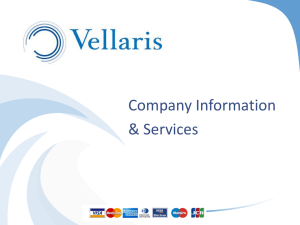
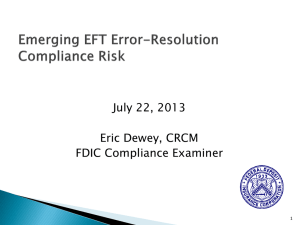
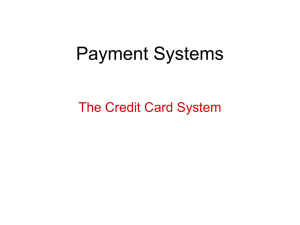


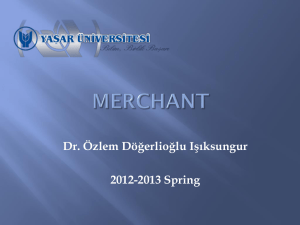
![platinum_presentation[1]](http://s2.studylib.net/store/data/005222927_1-20b6c53250f6dd80de50e457d09553b6-300x300.png)




